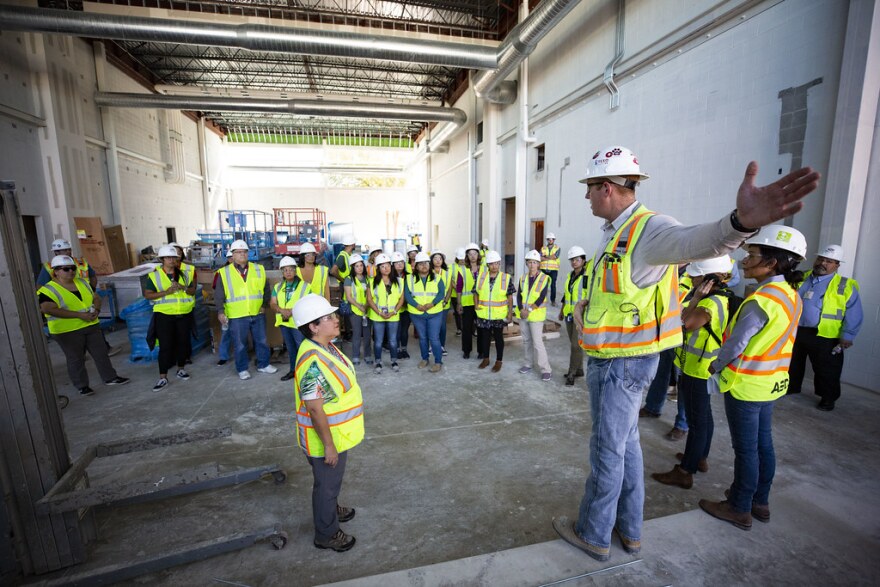Para leer una versión de este artículo en Español haga click aqui.
The school day is over, and a group of teachers from T.A. Brown Elementary and Webb Primary are standing outside a construction trailer, wearing safety vests, hard hats and protective glasses. They are about to get a tour of their new school.
“This is not very typical that we would bring this many people on a tour, especially this close to a job finishing,” says Drew Johnson, who works in AISD’s construction management department.
In 2016, a structural engineer found the crawl space at the old T.A. Brown building was crumbling. The damage could have caused the floor to collapse at any moment, so AISD immediately evacuated the school. Since then, students have been learning in trailer-like classrooms at other elementaries.
The district decided it needed to bulldoze the school and build a completely new, modernized building. When voters approved the 2017 bond, construction on the school could begin.
On this afternoon, the group stands in the cafeteria of the nearly complete building.
T.A. Brown is an extreme example of the dangers of older buildings. The majority of schools in the district are decades old, though, and in need of major repairs AISD says it can’t afford.

In the long run, AISD says, it's more affordable to build new schools, which wouldn't need constant maintenance. Modernized schools was a driving factor in what AISD is calling its "School Changes" plan. The plan proposes closing some schools and moving students to new modernized buildings.
“One of the purposes of the plan is to ensure we put as many students who have been marginalized in the past into 21st century, modernized learning spaces as quickly as possible," Gilbert Hicks, the associate superintendent of elementary schools, says. "That’s what this plan does.”
While AISD officials say new buildings are an important thing to prioritize, many in the community say the goal is misguided.

The Case For Modernized Schools
When school officials use the term “modernize,” they mean a few things. The building itself is new and designed in a completely different way from schools of the past. Classrooms aren’t enclosed and have plenty of windows. There are rooms for small groups, and spaces where multiple classrooms can work together on projects. Furniture moves around easily so a teacher can reconfigure a room to fit a particular lesson. New technology is in every room and available to every student.
The Manor Independent School District outside Austin started converting its schools to fit this model over the past few years.

Alice Fillmore is a kindergarten teacher at Lagos Elementary, the newest elementary school in the district. She’s been an educator for 25 years and started at Lagos this year after transferring from Manor Elementary, the oldest elementary school in the district. Manor ISD recently modernized that school as well, and she says it was hard to see a school she taught at for years get transformed.
“I had been with Manor Elementary for so long, but I think the new school is a lot better,” she says.
Fillmore says her favorite part of teaching at Lagos is that almost every wall in the two-story building is made of glass. When you walk along the main hallway on the second floor, you can look down into the library on one side and into the gym on the other. She likes that the principal and other teachers can observe her class without opening the door and interrupting.
Each grade level shares a hallway, and each classroom exits into a shared open space, where different classes work together on projects or activities.
“All five kinder classes – close to 100 kids – can gather together to have community activities," Fillmore says. "[The old school] didn’t have that much space for all the kids.”
She calls the new school “a blessing” for her and the students, because she doesn’t have to think about things like the air conditioner working or not having the right technology for her lessons. Staff said discipline is better, too, because the principal and teachers are able to keep their eyes on the students with everything so open.
“Security is something that I do like,” says kindergarten teacher Maria Stella Flores.
The front door of Lagos opens into a lobby where visitors meet a receptionist, who sits in front of locked doors. There's no other way for people to enter the school, which is often not the case at older schools. In many AISD schools, visitors often have to walk through a main hallway to get to the front office and check in.
“I like the double-door security,” Flores says. “I like that everybody who comes into the school interacts with someone before they get in.”
AISD says it would like to bring all these features to its schools.
Johnson says principals and communities will be able to work with architects and give input on features of a new school. At Brown, for example, staff asked for a kitchen to be built specifically for an after-school program on nutrition.
The Case Against New Buildings
Many parents of students at schools being considered for closure pushed back against the idea of closing one school so a modernized one could be built.
“I understand the need for 21st century buildings,” Pease parent Rose Guajardo says. “But what about the academics? What about the curriculum? What can we really give to our children that stays with them? A building is great – you’re here for a few years, you can say I went to a shiny building – but what do you get to carry on with you in your future?”
At community meetings, parents have said it feels as if AISD is trying to distract them with new buildings, rather than focusing on the negative impact closing a school could have on children and the community.
A school's closure can have emotional implications, too.
LC Anderson High School, sometimes called "Old Anderson," was the high school for black students during segregation. It was closed during desegregation efforts in the 1970s to force black and white students to go to school together.

Ora Houston, an Anderson alumnus and former City Council member, says Anderson is an example of the emotional and historical importance of school buildings. Anderson was a symbol of excellence for the black community in Austin during a time when the community was given few resources to succeed.
The district recently bulldozed the school to build a modernized one for Eastside Memorial High School.
“It’s unfortunate that I live in a community where my history is not valued as others are,” Houston says.
Even when the building was vacant or being used for other purposes, she says, its existence in the neighborhood was important for black Austinites to remember their past.
Houston says when she lived in other cities, she would drive by the old building whenever she returned.
“I had a sense of place,” she says. “Not only did I go there – and they set high expectations for us all – many other people went there and made names for themselves and contributed to society. And yet, there’s nothing there that says, ‘This was a great place.’”
And that's a concern people connected to Brooke, Metz, Sims and Pease have now. As Austin changes so quickly, school buildings are one of the last reminders of what a community used to look like in some neighborhoods.






